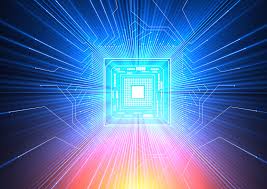Source: analyticsinsight.net
The pace of improvement in quantum computing mirrors the fast advances made in AI and machine learning. It is normal to ask whether quantum technologies could boost learning algorithms: this field of inquiry is called quantum-improved machine learning.
Quantum computers are gadgets that work dependent on principles from quantum physics. The computers that we at present use are constructed utilizing transistors and the information is stored as double 0 and 1. Quantum computers are manufactured utilizing subatomic particles called quantum bits, qubits for short, which can be in numerous states simultaneously. The principal advantage of quantum computers is that they can perform exceptionally complex tasks at supersonic velocities. In this way, they take care of issues that are not presently feasible.
The most significant advantage of quantum computers is the speed at which it can take care of complex issues. While they’re lightning speedy at what they do, they don’t give abilities to take care of issues from undecidable or NP-Hard problem classes. There is a problem set that quantum computing will have the option to explain, anyway, it’s not applicable for all computing problems.
Ordinarily, the issue set that quantum computers are acceptable at solving includes number or data crunching with an immense amount of inputs, for example, “complex optimisation problems and communication systems analysis problems” — calculations that would normally take supercomputers days, years, even billions of years to brute force.
The application that is routinely mentioned as an instance that quantum computers will have the option to immediately solve is solid RSA encryption. A recent report by the Microsoft Quantum Team recommends this could well be the situation, figuring that it’d be feasible with around a 2330 qubit quantum computer.
Streamlining applications leading the pack makes sense well since they’re at present to a great extent illuminated utilizing brute force and raw computing power. If quantum computers can rapidly observe all the potential solutions, an ideal solution can become obvious all the more rapidly. Streamlining stands apart on the grounds that it’s significantly more natural and simpler to get a hold on.
The community of people who can fuse optimization and robust optimization is a whole lot bigger. The machine learning community, the coinciding between the innovation and the requirements are technical; they’re just pertinent to analysts. What’s more, there’s a much smaller network of statisticians on the planet than there are of developers.
Specifically, the unpredictability of fusing quantum computing into the machine learning workflow presents an impediment. For machine learning professionals and analysts, it’s very easy to make sense of how to program the system. Fitting that into a machine learning workflow is all the more challenging since machine learning programs are getting very complex. However, teams in the past have published a lot of research on the most proficient method to consolidate it in a training workflow that makes sense.
Undoubtedly, ML experts at present need another person to deal with the quantum computing part: Machine learning experts are searching for another person to do the legwork of building the systems up to the expansions and demonstrating that it can fit.
In any case, the intersection of these two fields goes much further than that, and it’s not simply AI applications that can benefit. There is a “meeting area where quantum computers perform machine learning algorithms and customary machine learning strategies are utilized to survey the quantum computers. This region of research is creating at such bursting speeds that it has produced a whole new field called Quantum Machine Learning.
This interdisciplinary field is incredibly new, however. Recent work has created quantum algorithms that could go about as the building blocks of machine learning programs, yet the hardware and programming difficulties are as yet significant and the development of fully functional quantum computers is still far off.
The future of AI sped along by quantum computing looks splendid, with real-time human-imitable practices right around an inescapable result. Quantum computing will be capable of taking care of complex AI issues and acquiring multiple solutions for complex issues all the while. This will bring about artificial intelligence all the more effectively performing complex tasks in human-like ways. Likewise, robots that can settle on optimised decisions in real-time in practical circumstances will be conceivable once we can utilize quantum computers dependent on Artificial Intelligence.
How away will this future be? Indeed, considering just a bunch of the world’s top organizations and colleges as of now are growing (genuinely immense) quantum computers that right now do not have the processing power required, having a multitude of robots mirroring humans running about is presumably a reasonable way off, which may comfort a few people, and disappoint others. Building only one, however? Perhaps not so far away.
Quantum computing and machine learning are incredibly well matched. The features the innovation has and the requirements of the field are extremely close. For machine learning, it’s important for what you have to do. It’s difficult to reproduce that with a traditional computer and you get it locally from the quantum computer. So those features can’t be unintentional. It’s simply that it will require some time for the people to locate the correct techniques for integrating it and afterwards for the innovation to embed into that space productively.
